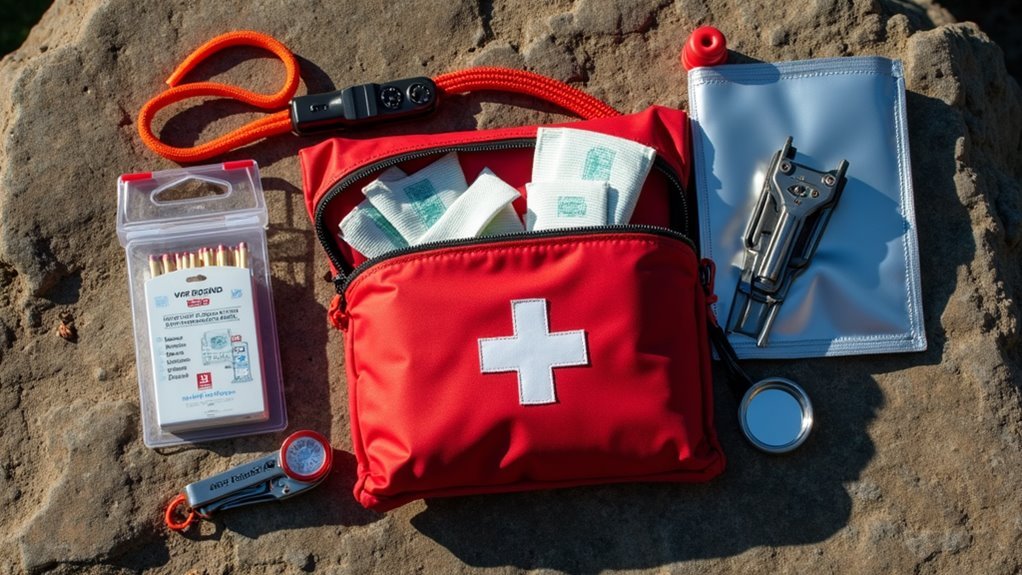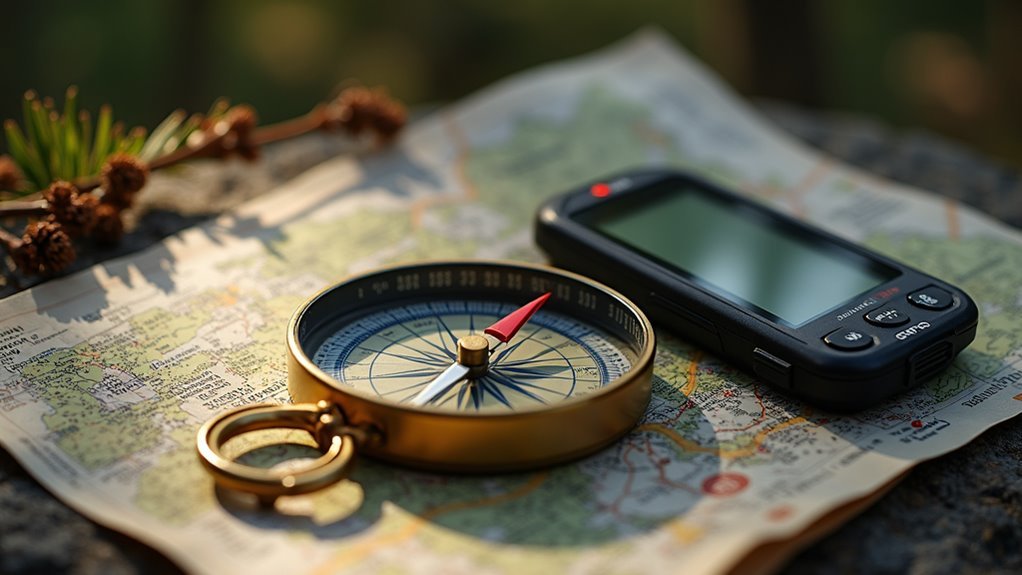I’ve found that certain essentials can make or break any backpack adventure, though I sometimes overthink what’s truly necessary. A basic first aid kit with band-aids and antiseptic wipes tops my list, followed by reliable hydration options like insulated bottles or collapsible ones for space-saving. I always pack a portable power bank—at least 10,000mAh works best—plus backup charging cables since phones die at the worst moments. Perhaps most importantly, I include non-perishable snacks and emergency items for unexpected situations that’ll help you stay prepared for whatever comes next.
Essential Safety and First Aid Supplies

When you’re putting together any backpack—whether it’s for a day hike or just your daily commute—I think safety items often get overlooked until you actually need them. A basic first aid kit doesn’t take much space, but it’s clutch when someone gets a cut or scrape. I always throw in some band-aids and antiseptic wipes.
Sunscreen’s another one I forget about sometimes, though UV protection matters even on cloudy days.
A small flashlight or headlamp can be a lifesaver if you’re stuck somewhere after dark. Perhaps these items seem excessive for everyday carry, but they’ve saved me more than once.
Hydration Systems and Water Storage Solutions
Staying properly hydrated is something I’ve learned not to mess around with, especially after a few uncomfortable experiences where I didn’t bring enough water.
I think the key is having multiple options rather than relying on just one bottle.
Diversifying your hydration gear prevents you from getting caught short when one option fails or runs empty.
Hydration bladders are brilliant for longer adventures. They hold more water and let you drink hands-free through a tube. Perhaps they’re overkill for casual use, but once you try them, regular bottles feel limiting.
For everyday carry, I prefer insulated bottles that keep drinks cold. Some people swear by collapsible options to save space when empty.
Navigation Tools for Any Journey

Even though we live in an age where GPS seems infallible, I’ve learned that having backup navigation tools isn’t just smart—it’s essential.
Batteries die at the worst moments, and signals vanish when you need them most.
I always carry a basic compass and waterproof map, even on familiar trails. Perhaps it’s overkill for city adventures, but I think the peace of mind is worth a few extra ounces.
A simple compass doesn’t need charging or satellite coverage.
These analog tools have saved me more than once when technology failed unexpectedly during outdoor excursions.
Power and Connectivity Essentials
Three things consistently drain my phone battery faster than I expect: GPS navigation, taking photos, and that inevitable moment when I need to make an important call with 5% battery remaining.
I’ve learned that freedom means staying connected when it matters most. Here’s what keeps me powered up:
- Portable power bank – 10,000mAh minimum capacity
- Universal charging cable – USB-C with multiple adapters
- Solar charger – perhaps overkill, but useful for extended trips
- Backup earbuds – because the primary pair always disappears
These items have saved me countless times, though I think the solar charger sits unused more often than I’d admit.
Weather Protection and Comfort Items

Weather changes faster than I can check forecasts, and I’ve been caught in unexpected downpours more times than I care to admit. That’s why I always pack protection, even when skies look clear.
A compact rain jacket takes minimal space but saves the day when storms hit. I think an umbrella’s worth considering too, though some might disagree.
| Item | Why It Matters |
|---|---|
| Rain jacket | Lightweight, essential protection |
| Small towel | Quick-dry for unexpected situations |
| Sunglasses | Eye protection, reduces strain |
| Emergency blanket | Warmth, perhaps overkill but useful |
These comfort items transform miserable situations into manageable ones.
Lighting Equipment for Low-Light Situations
When darkness falls unexpectedly, you’ll appreciate having reliable lighting within arm’s reach.
I’ve found myself in too many situations where my phone’s flashlight just wasn’t enough – or worse, when my battery was dead.
Here’s what I think every backpack needs for lighting:
- Headlamp – Hands-free illumination that’s perhaps the most versatile option
- Small LED flashlight – Compact backup that never lets you down
- Emergency glow sticks – Long-lasting light source that doesn’t need batteries
- Keychain light – Tiny but surprisingly useful for quick tasks
These options give you freedom to navigate confidently, whether you’re camping or just walking home late.
Food and Nutrition Basics
Since your energy levels directly impact everything from decision-making to physical endurance, I’d argue that food might be the most underestimated item in any backpack.
I’ve learned this the hard way during long days when my stomach started growling at the worst possible moments.
Non-perishable options work best—nuts, dried fruit, energy bars.
Perhaps trail mix if you’re feeling fancy.
I think the key is balancing convenience with actual nutrition, though honestly, sometimes a simple granola bar beats carrying elaborate meal prep.
You want foods that won’t spoil, crush easily, or require preparation.
Your future hangry self will thank you.
Academic and Professional Organization Tools
Three things separate organized people from those constantly scrambling through their bags: they plan ahead, they compartmentalize, and they actually use the tools they carry.
Organization isn’t about having perfect systems—it’s about consistently using the simple tools that actually work for your lifestyle.
I’ve watched countless students dig frantically through backpacks for a single pen. It’s painful, honestly. Your freedom depends on having what you need when you need it.
Essential organization tools that’ll change your life:
- Dedicated notebook or planner – Digital’s great, but sometimes you need paper
- Reliable writing utensils – Pack extras because they disappear
- Small pouches or organizers – Compartmentalize everything
- Portable charger – Dead devices kill productivity
Perhaps these seem basic, but I think simplicity works best for staying genuinely organized.
Footwear and Support Accessories
Your feet carry you everywhere, yet most people stuff them into whatever shoes happened to be by the door that morning.
I think that’s backwards – your footwear deserves more thought, especially when you’re carrying a loaded pack.
Quality insoles can transform any shoe into something more supportive. Perhaps they’re not glamorous, but they matter more than you’d expect.
Trekking poles aren’t just for serious hikers; they reduce knee strain during any walk with weight on your back.
Compression socks help circulation during long days. Your ankles and calves will thank you later, even if you’re just traversing campus or city streets.
Multipurpose Items That Save Space
How much space could you actually save if every item in your backpack served multiple purposes? I think the answer might surprise you – perhaps more than you’d expect.
When I’m planning adventures, multipurpose gear becomes my best friend.
These items let me break free from overpacking while staying prepared:
- Bandana – works as headband, first aid material, or cleaning cloth
- Smartphone with offline maps – replaces compass, camera, and entertainment
- Duct tape wrapped around trekking poles – repairs gear without extra weight
- Multi-tool – combines knife, scissors, and screwdriver functions
Smart packing means freedom to roam without unnecessary bulk.
Frequently Asked Questions
How Much Weight Should a Backpack Hold Before It Becomes Uncomfortable?
I’d recommend keeping your backpack weight under 10-15% of your body weight for daily use. Beyond that threshold, you’ll start experiencing shoulder strain, back discomfort, and reduced mobility that’ll limit your adventures.
What’s the Ideal Backpack Capacity for Different Types of Day Trips?
I’d recommend 15-20 liters for short city walks, 20-25 liters for hiking adventures, and 25-30 liters when you’re carrying extra gear or planning longer explorations where you’ll need more supplies.
How Often Should Backpack Essentials Be Rotated or Replaced for Freshness?
I’ll rotate my food and water monthly, replace sunscreen annually, and check batteries quarterly. First aid supplies need yearly updates, while gear like maps should refresh when exploring new areas for ideal safety.
Can Backpack Materials Affect the Temperature of Items Stored Inside?
Backpack materials absolutely affect internal temperatures. I’ve noticed darker colors absorb more heat, while lighter fabrics reflect it. Insulated compartments help maintain temperatures, but standard materials won’t protect your items from extreme heat or cold.
What’s the Best Way to Clean and Maintain a Backpack Long-Term?
While adventure calls you forward, I’ll keep my backpack maintained by regularly emptying and vacuuming it, spot-cleaning stains with mild soap, air-drying completely, and checking zippers and straps for wear.
Conclusion
Your backpack becomes more than fabric and zippers—it’s your anchor in uncertainty. I’ve learned that the right gear transforms any journey, though perhaps I’m overstating its importance. Each carefully chosen item represents a small victory against the unpredictable. Whether you’re scaling peaks or rushing to class, your pack holds the tools that bridge the gap between preparation and possibility. It’s honestly surprising how much confidence a well-stocked bag provides.